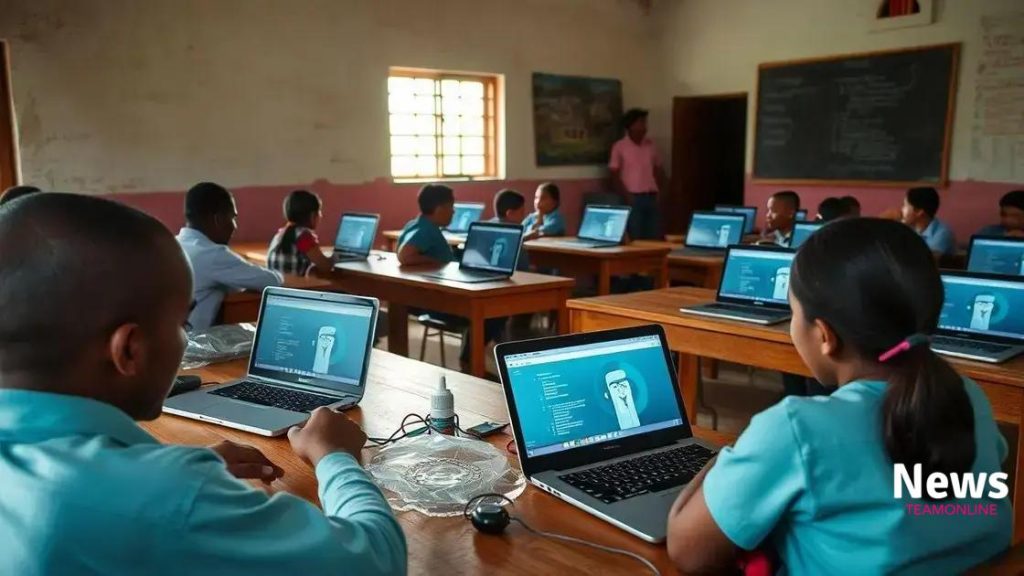Rural school internet policy: bridging the digital divide

The rural school internet policy focuses on improving connectivity by addressing infrastructure gaps, fostering community involvement, and implementing innovative educational strategies to enhance learning opportunities for students in remote areas.
Rural school internet policy is essential for ensuring that students in remote areas have equal access to educational resources. With the right strategies and investments, we can transform learning for many. Curious how this impacts daily education? Let’s dive in.
Understanding rural school internet challenges
Understanding the challenges of internet access in rural schools is crucial for fostering educational equity. Many students face significant barriers that prevent them from fully participating in the digital age. It’s vital to acknowledge these issues to create effective solutions.
Key Challenges Faced by Rural Schools
Rural schools consistently struggle with various obstacles. One major concern is connectivity. Many areas lack reliable internet service, which can hinder student learning. Additionally, the infrastructure in rural communities often fails to meet the growing demands of digital education.
- Low broadband coverage in remote locations
- Limited funding for technological upgrades
- Low digital literacy among staff and students
- Inconsistent support from local governments
Moreover, students in rural settings may have to travel long distances to access resources that urban counterparts take for granted. This situation can leave them behind and impact their performance. Furthermore, the lack of devices at home adds another layer of complexity. While schools may have computers, not every student has a laptop or tablet to continue their studies remotely.
The Importance of Addressing Connectivity
Addressing connectivity issues is essential for ensuring that rural students can compete equally. Initiatives that provide subsidized internet access or community Wi-Fi hotspots are vital. These programs help close the gap. However, they require collaboration between schools, government, and technology companies.
By strengthening these partnerships, increased investment can lead to sustainable solutions. Schools need to advocate for more resources to improve infrastructure and enhance digital literacy among students and staff.Understanding these challenges is the first step towards driving change. With concerted effort, we can transform these barriers into opportunities for growth and learning.
The role of policy in improving connectivity
The role of policy in improving connectivity for rural schools cannot be overstated. Effective policies are crucial in addressing the digital divide that exists between urban and rural education systems. Policymakers have the ability to create frameworks that support internet expansion in underserved areas.
Key Policy Initiatives
Many successful initiatives have shown how policies can transform connectivity. For instance, government funding can be allocated to enhance broadband infrastructure. Additional regulations can encourage telecommunications companies to invest in rural networks.
- Expanding federal grant programs for rural broadband
- Incentives for private companies to build infrastructure
- Policies facilitating community-led internet projects
- Partnerships with educational institutions for training
Furthermore, promoting transparency in data reporting ensures that areas lacking service receive necessary attention. Policymakers need to actively engage with communities to identify specific needs, which can lead to more tailored solutions.
Community Engagement and Feedback
Engaging the community is essential for understanding on-the-ground challenges. Through town hall meetings and surveys, communities can voice their connectivity needs. This feedback helps shape effective policies. When families express their experiences with internet access, it allows stakeholders to see the real impact on education.
Involving educators in policy discussions also ensures that the solutions proposed meet the needs of students. Policy initiatives that prioritize connectivity can create an environment where rural students thrive. With the right approach, we can pave the way for better educational opportunities through improved internet access.
Success stories: impactful internet interventions

Success stories surrounding impactful internet interventions show how targeted efforts can transform rural education. Many schools have experienced significant improvements in access and learning outcomes through innovative strategies.
Case Studies of Effective Interventions
One notable example is the initiative in XYZ County, where local schools collaborated with internet service providers to create a community-wide Wi-Fi network. This network allowed students to access resources from home, which greatly enhanced their learning experience. Such partnerships illustrate how working together can lead to effective solutions.
- Community partnerships improving infrastructure
- Programs providing devices to students
- Investment in teacher training for digital tools
- Involvement of local businesses in supporting initiatives
Furthermore, programs like ABC Program have been shown to increase digital literacy among students and teachers. This initiative focused on training educators, equipping them to harness the power of technology effectively.
Impact on Student Engagement
These interventions have not only improved connectivity but also boosted student engagement. As access to the internet became more widespread, students developed a greater interest in their studies. For instance, teachers reported more participation in class discussions and improved performance on assignments.
By sharing these success stories, we can inspire other communities to take action. Highlighting effective strategies builds a positive narrative around the potential of internet access in rural areas. Success stories serve as a powerful reminder that with determination and collaboration, we can make significant advancements in connecting students to the digital world.
Strategies for effective internet implementation
Strategies for effective internet implementation in rural schools are essential for bridging the digital divide. By focusing on practical solutions, we can ensure that every student has the opportunity to thrive in a connected world.
Building Infrastructure
One of the most important steps is to develop the necessary infrastructure. This means working with local and national providers to enhance broadband access. Community-driven projects can also play a key role. For example, establishing local Wi-Fi networks in community centers can create a hub for students.
- Engage local governments for support
- Invest in community Wi-Fi initiatives
- Collaborate with internet service providers
- Utilize grants for infrastructure development
In addition, schools should assess their current technology to identify areas for improvement. By upgrading outdated systems, they can better support online learning and resource access.
Providing Training and Resources
Another critical strategy is offering training for both teachers and students. Ensuring educators are equipped with the skills to use technology effectively fosters a better learning environment. This can include professional development workshops on integrating technology into the classroom.
On the student side, programs that provide digital literacy training can be invaluable. Teaching students to navigate online resources prepares them for the challenges of modern education. Many communities have seen improvements when they focus on teaching essential skills alongside providing resources.
Additionally, implementing mentorship programs can connect students with peers who are proficient in technology. Strategies that prioritize collaborative learning can significantly impact student engagement and success. By creating a supportive educational ecosystem, we prepare our future leaders for a more connected world.
Future prospects for rural education and technology
The future prospects for rural education and technology hold great promise as we continue to embrace innovation. As technology evolves, so does the potential for enhancing educational opportunities for students in rural areas.
Advancements in Online Learning
One of the most significant shifts is the rise of online learning platforms. These platforms provide flexible learning options and diverse resources. Many rural schools are already integrating these tech solutions to expand educational offerings beyond traditional classrooms.
- Increased access to high-quality courses
- Opportunities for collaboration with urban schools
- Use of virtual reality for interactive learning experiences
- Customized learning paths for each student
Moreover, the growth of mobile technology allows teachers to reach students in remote locations. With the right support, students can access lessons and materials from anywhere, even in their homes.
Increased Community Involvement
Future initiatives will likely focus on increased community involvement. Local businesses and organizations can play a vital role in supporting educational tech initiatives. They can provide funding, resources, and training to enhance the learning environment.
Additionally, as more communities recognize the importance of education, partnerships will strengthen. These connections foster a collaborative approach, enhancing resources and technology available to schools.
As we look ahead, it is clear that rural education and technology are on a path toward significant improvement. Emerging trends and increased investment in tech solutions will create a brighter future for students, ensuring they are equipped with the skills needed for success in a digital world.
FAQ – Frequently Asked Questions about Rural School Internet Policy
What challenges do rural schools face regarding internet access?
Rural schools often struggle with low broadband coverage, limited funding for technological upgrades, and inadequate local infrastructure.
How can community support improve internet connectivity?
Community involvement, including partnerships with local businesses, can provide essential resources and funding to enhance internet infrastructure.
What role does policy play in enhancing student internet access?
Policy initiatives can drive funding, promote infrastructure development, and encourage telecommunications companies to invest in rural internet services.
What are some successful strategies for implementing internet in rural schools?
Successful strategies include building community Wi-Fi networks, providing training for teachers, and utilizing online learning platforms to expand educational opportunities.





